UUV在水下搜索的军事行动中具有非常广泛的应用,凭借低成本、高隐蔽等特性,可以在敏感区域或危险区域执行反潜跟踪、区域警戒、反水雷等任务,与潜艇及反潜水面舰艇等有人兵力密切配合,提升水下体系作战能力[1-2]。
当前UUV水下搜索问题的研究,大多基于相对成熟的潜艇搜索模型展开,尚未有针对UUV特性而专门建立的搜索模型[3]。从平台搭载的传感器来看,UUV与潜艇均依赖声呐水下搜索,但考虑平台性能和尺度差异,潜艇等大型平台能源及空间相对充沛,可以于不同位置配置多套声呐,进而可以将平台的探测范围等效为一个以声呐作用距离为半径的圆,即可认为潜艇是全向搜索的。而UUV由于能源及传感器布置空间相对有限,通常于特定位置搭载相对较少的声呐,若仍将其等效为全向搜索,忽略探测扇面角的影响,则显然不满足UUV的实际情况,从而对其搜索能力的计算产生影响。综合调查REMUS,Bluefin,Hugin等系列典型UUV的声呐载荷,根据搜索探测用声呐布置位置的不同,大体可以分为首部声呐和舷侧声呐,且两类声呐的探测扇面关于UUV轴线纵对称[4-5]。布置位置的差异及扇面角的不同显然使UUV的探测范围也随之变化,因此有必要综合考虑相关因素,建立适于UUV特性的搜索模型,从而便于更好地开展UUV水下搜索问题的研究。
1 UUV随机搜索中的数学模型随机搜索是一种典型搜索方式,也是分析其他类型搜索问题的重要依据。如图1所示,随机搜索指的是搜索者和目标在一定区域内可能采取任意航向的搜索过程[6-7]。这种搜索过程通常适用于已知目标存在于某一区域、但其具体运动路径未知的搜索问题。
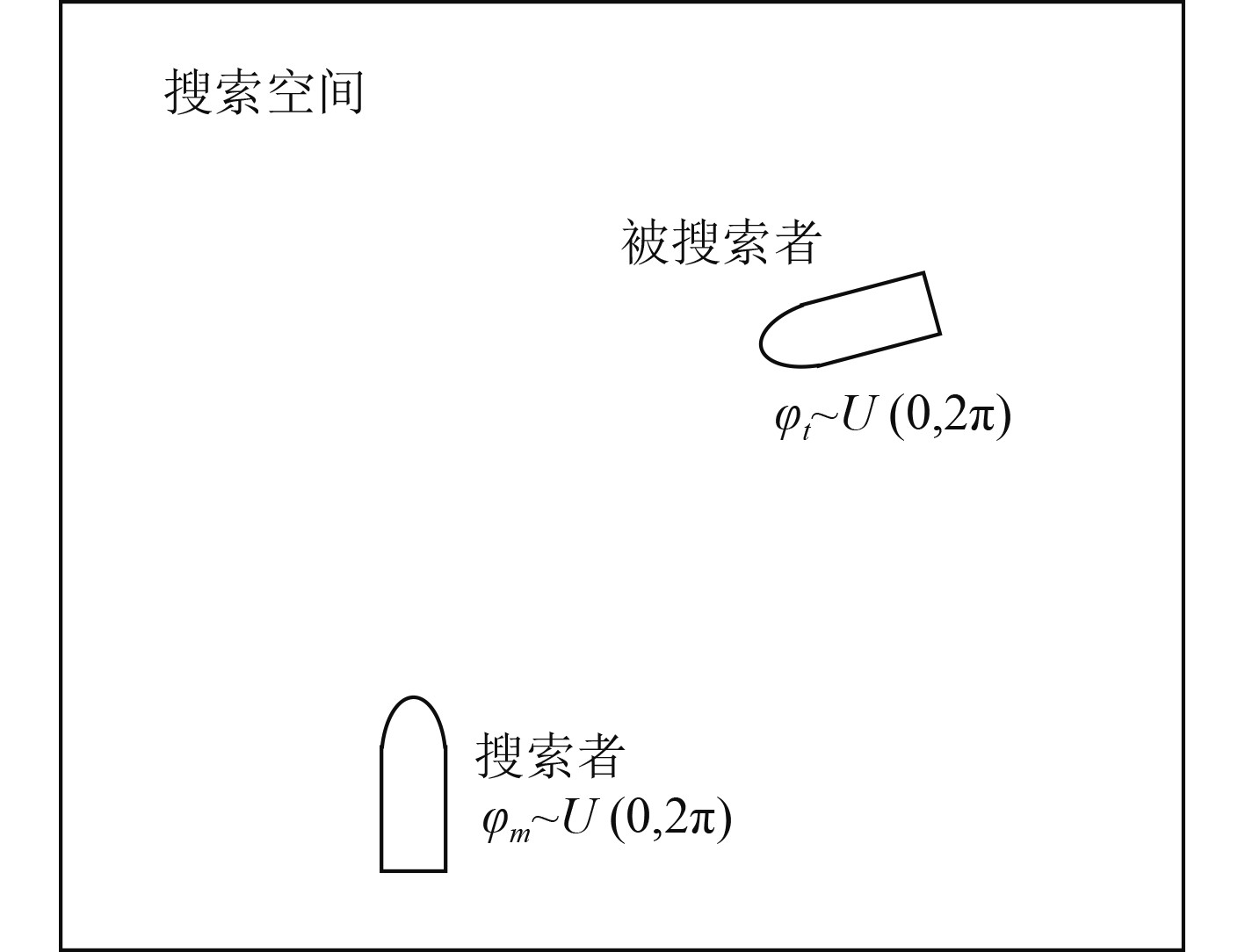
|
图 1 随机搜索方式示意图 Fig. 1 Diagram of random search |
基于搜索论的相关结论,随机搜索总的发现概率为:
| $ P\left( t \right) = 1 - \exp \left( { - \frac{{VWt}}{A}} \right)。$ | (1) |
式中:
在随机搜索中,令UUV航速为
| $ \begin{split} F\left( {\Delta \varphi } \right) =& P\left( {{\varphi _m} - {\varphi _t} \leqslant \Delta \varphi } \right) =\\ &\left\{ {\begin{array}{*{20}{l}} {\dfrac{{{{\left( {2{\text{π}} + \Delta \varphi } \right)}^2}}}{{8{{\text{π}} ^2}}}},&{\Delta \varphi \in \left( { - 2{\text{π}} ,0} \right)},\\ {1 - \dfrac{{{{\left( {2{\text{π}} - \Delta \varphi } \right)}^2}}}{{8{{\text{π}} ^2}}}},&{\Delta \varphi \in \left[ {0,2{\text{π}} } \right)} 。\end{array}} \right. \end{split} $ | (2) |
取微分后有
| $ f\left( {\Delta \varphi } \right) = F'\left( {\Delta \varphi } \right) = \left\{ {\begin{array}{*{20}{l}} {\dfrac{{2{\text{π}} + \Delta \varphi }}{{4{{\text{π}} ^2}}}},&{\Delta \varphi \in \left( { - 2{\text{π}} ,0} \right)},\\ {\dfrac{{2{\text{π}} - \Delta \varphi }}{{4{{\text{π}} ^2}}}},&{\Delta \varphi \in \left[ {0,2{\text{π}} } \right)} 。\end{array}} \right. $ | (3) |
显然
| $ \begin{array}{*{20}{c}} {f\left( {\Delta \varphi } \right) = \dfrac{1}{{2{\text{π}} }}}&{\Delta \varphi \in \left[ {0,2{\text{π}} } \right)}。\end{array} $ | (4) |
式(4)表明
| $ \begin{split}{\overline{V}}_{s}=&{\displaystyle{\int _{0}^{{2{\text{π}} }}}f\left(\Delta \phi \right)\sqrt{{U}^{2}+{V}^{2}-2UV\mathrm{cos}\Delta \phi }{\rm{d}}\Delta \phi }=\\ &\dfrac{\sqrt{{U}^{2}+{V}^{2}}}{{\text{π}} }\displaystyle\int_{0}^{\text{π}} \sqrt{1-\dfrac{2UV}{{U}^{2}+{V}^{2}}\left[2{\mathrm{cos}}^{2}\dfrac{\Delta \phi }{2}-1\right]}{\rm{d}}\Delta \phi =\\ &\dfrac{2\left(U+V\right)}{{\text{π}} }{\displaystyle\int_{-\tfrac{{\text{π}} }{2}}^{0} \sqrt{1-\dfrac{4UV}{{\left(U+V\right)}^{2}}{\mathrm{sin}}^{2}\alpha }{\rm{d}}\alpha } =\\ &\dfrac{2\left(U+V\right)}{{\text{π}} }{E}_{\mathrm{II}}\left(\dfrac{4UV}{{\left(U+V\right)}^{2}}\right)。\end{split} $ | (5) |
式中:
前文已证
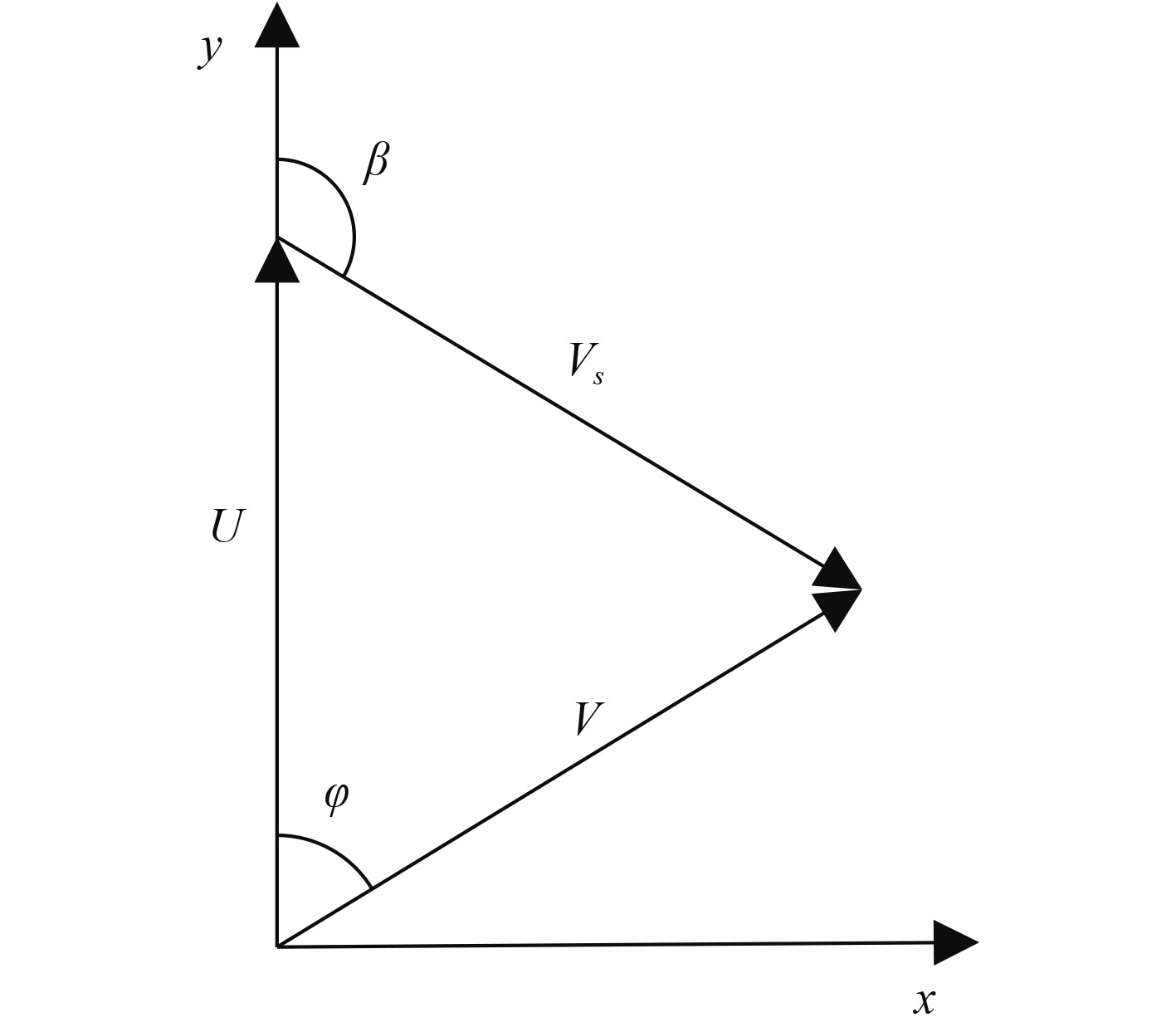
|
图 2 坐标系建立方法示意图 Fig. 2 Establishment of coordinate |
考虑对称性,仅讨论
| $ \begin{split} {F_1}(\beta ) =& P\left\{ {\arctan \frac{{\sin \varphi }}{{\cos \varphi - k}} \leqslant \beta } \right\} =\\ &\frac{{\arccos \left( {{K_2} - {K_1}} \right) - \arccos \left( {{K_2} + {K_1}} \right)}}{\text{π} } 。\end{split} $ | (6) |
式中:
当
| $ \begin{array}{*{20}{c}} {{F_2}\left( \beta \right) = \dfrac{{2\beta - {\text{π}} }}{{\text{π}} }},&{\beta \in \left[ {\dfrac{{\text{π}} }{2},{\text{π}} } \right)} ,\end{array} $ | (7) |
当
| $ {F_3}\left( \beta \right) = \left\{ {\begin{array}{*{20}{c}} {\dfrac{{\arccos \left( {{K_2} + {K_1}} \right)}}{{\text{π}} }},&{\beta \in \left[ {0,\dfrac{{\text{π}} }{2}} \right)} ,\\ {\dfrac{{\arccos \left( {{K_2} - {K_1}} \right)}}{{\text{π}} }},&{\beta \in \left[ {\dfrac{{\text{π}} }{2},{\text{π}} } \right)} 。\end{array}} \right. $ | (8) |
对上述分布函数
根据文献[8],搜扫宽度基于横向距离的积分确定,而横向距离指的是在距离最近点处搜索者和目标之间的距离。由此,当仅配置首部声呐时,如图3所示。令声呐作用距离为
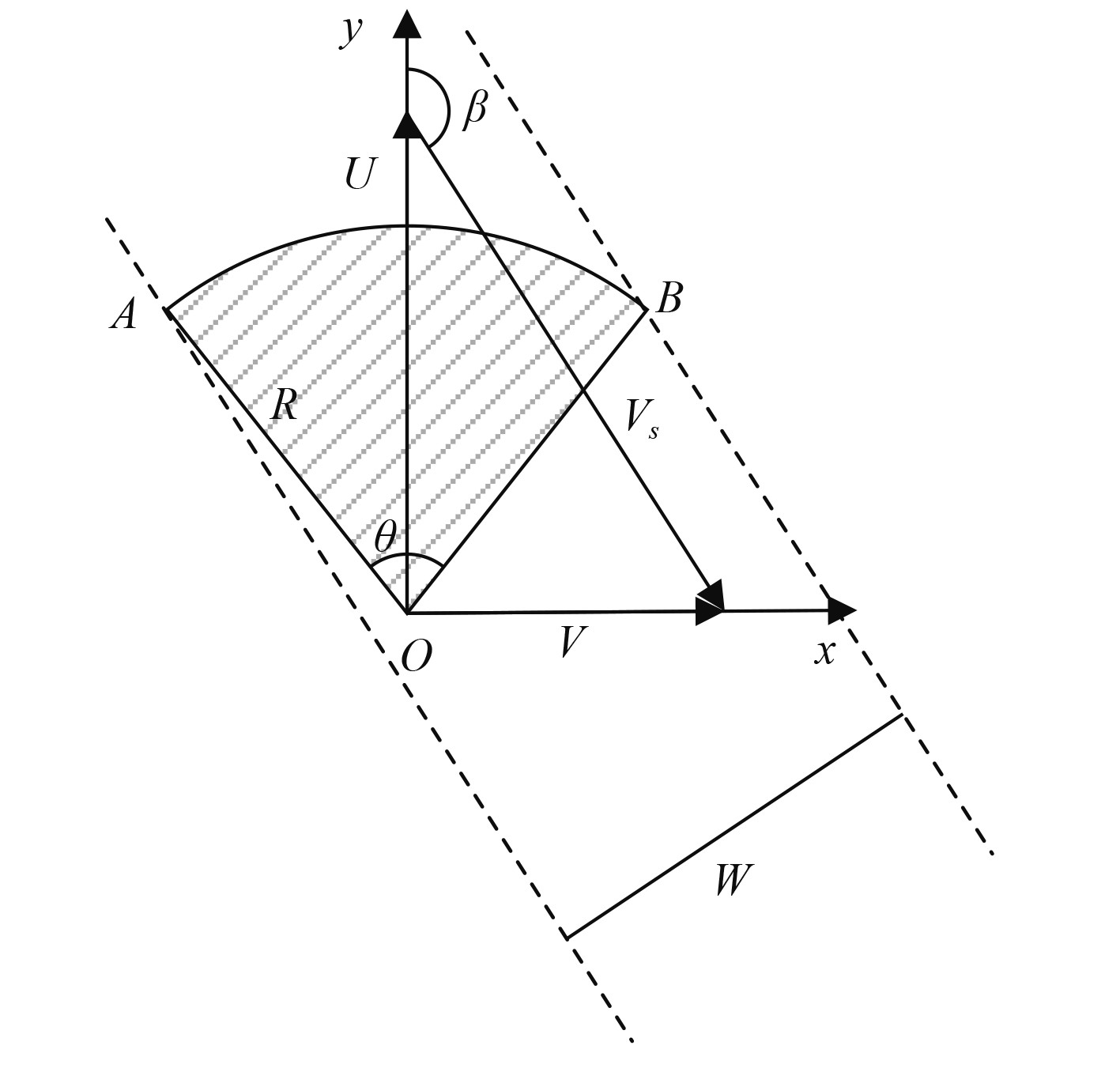
|
图 3 首部声呐搜扫宽度确定方法示意图 Fig. 3 Daigram of bow sonar search width |
若
| $ {W_1} = 2R\sin \frac{\theta }{2}\cos \beta,$ | (9) |
当
| $ {W_2} = R\sin \left( {\beta + \frac{\theta }{2}} \right) ,$ | (10) |
当
| $ {W_3} = R,$ | (11) |
当
| $ {W_4} = R\sin \left( {\beta - \frac{\theta }{2}} \right)。$ | (12) |
当
| $ {W_5} = 2R\sin \frac{\theta }{2}\cos \left( {{\text{π}} - \beta } \right)。$ | (13) |
同理,若
| $ {W'_1} = {W_1},$ | (14) |
当
| $ {W'_2} = R + R\sin \left( {\frac{\theta }{2} - \beta } \right) 。$ | (15) |
当
| $ {W'_3} = {W_3},$ | (16) |
当
| $ {W'_4} = R - R\sin \left( {\frac{\theta }{2} + \beta } \right)。$ | (17) |
当
| $ {W'_5} = {W_5}。$ | (18) |
如图4所示,当仅配置舷侧声呐时,搜扫宽度确定方法相同。

|
图 4 舷侧声呐搜扫宽度确定方法示意图 Fig. 4 Daigram of side sonar search width |
当
| $ {W_1} = 2R,$ | (19) |
当
| $ {W_2} = 2R\sin \left( {\frac{{\text{π}} }{2} + \frac{\theta }{2} - \beta } \right) ,$ | (20) |
当
| $ {W_3} = 2R\sin \left( {\beta + \frac{\theta }{2} - \frac{{\text{π}} }{2}} \right) ,$ | (21) |
当
| $ {W_4} = 2R,$ | (22) |
综合式(6)~式(22),搜扫宽度
| $ \bar W = \int {F'\left( \beta \right)W\left( {\beta ,\theta } \right)} {\rm{d}}\beta。$ | (23) |
其中,
巡逻线搜索指的是搜索者垂直于目标可能航向所进行的线式搜索。这种搜索方式通常是在目标可能航向较为确定的情况下,为以最大概率发现目标而采用[9]。本质上看,这种方式不属于随机搜索,因为目标航向已知从而不再满足均匀分布的条件,但前文所建立的搜索模型经适当变形后仍可用于求解该类问题。
在巡逻线搜索中,显然
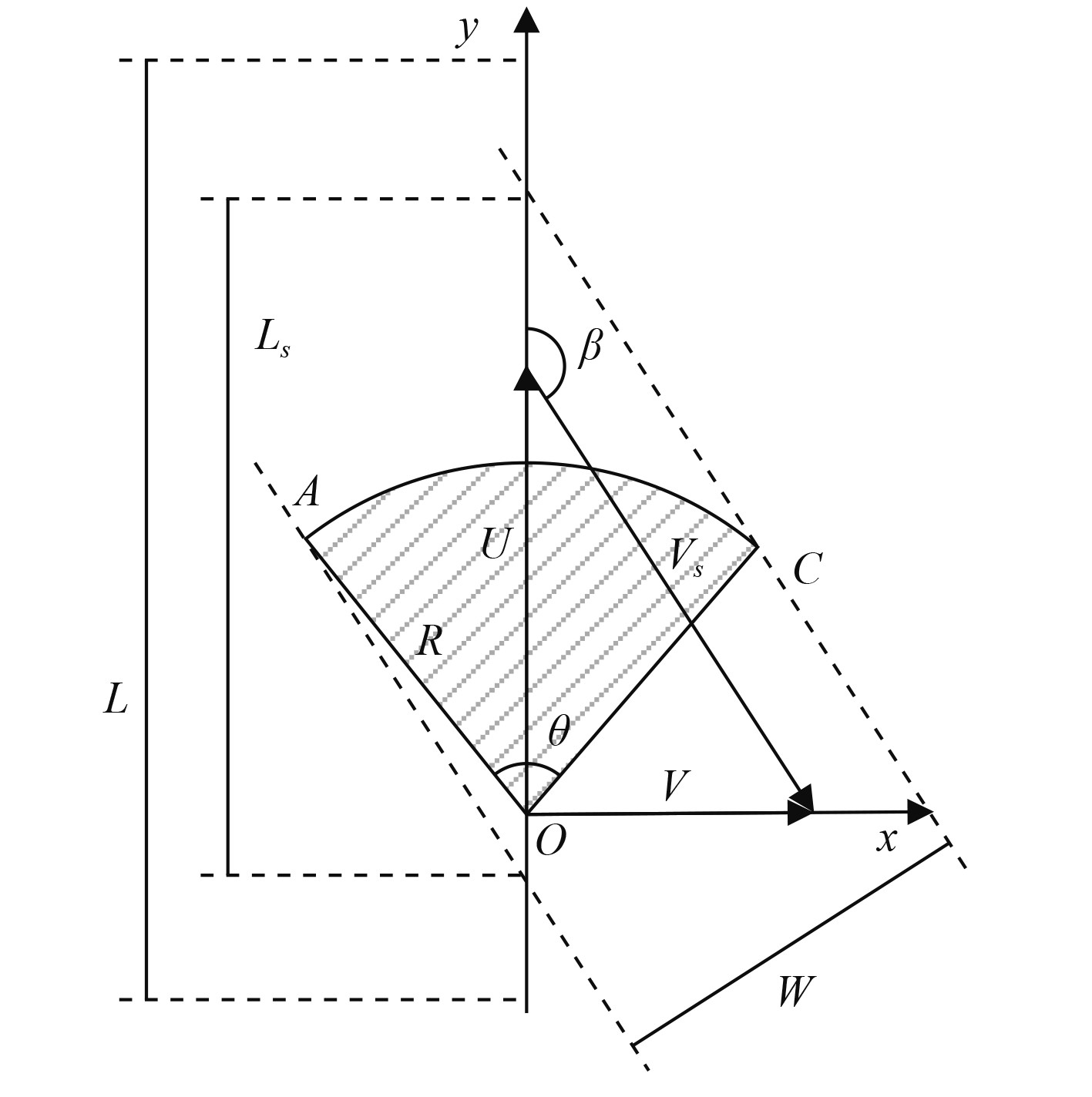
|
图 5 巡逻线搜索示意图 Fig. 5 Schematic of line search |
| $ P\left( \beta \right) = \frac{1}{{{L^2}}}\left[ {\frac{{W\left( \beta \right)L}}{{\sin \beta }} - \frac{{{W^2}\left( \beta \right)}}{{2{{\sin }^2}\beta }} - K\left( {\beta ,\theta } \right)} \right]。$ | (24) |
式中:当
设计仿真试验,UUV以首部声呐进行巡逻线搜索,
|
|
表 1 巡逻线搜索发现概率理论值 Tab.1 Theoretical probability of line search |

|
图 6
巡逻线搜索仿真结果与理论值对比图(
|
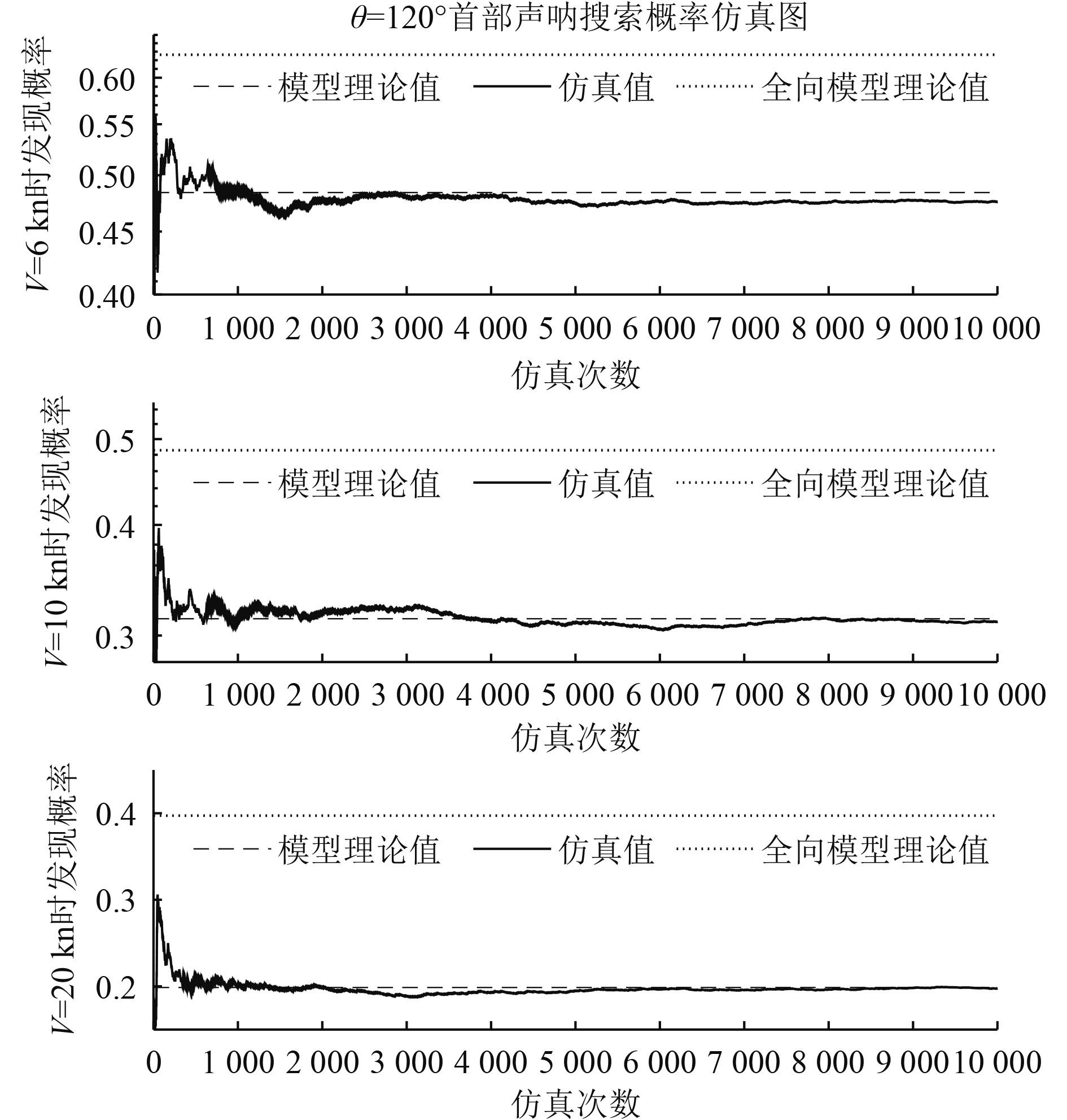
|
图 7
巡逻线搜索仿真结果与理论值对比图(
|
可以看出,随着仿真次数的增加,仿真计算给出的发现概率较快的收敛于基于式(24)给出的理论概率,且可以看出,若采用将搜扫宽度等效为传感器作用距离两倍的全向搜索模型,则发现概率的计算将有较大误差,从而验证了前文建立的模型在巡逻线搜索问题中的有效性与准确性。
2.2 随机搜索问题的仿真验证设计仿真试验,令UUV和目标在一宽为
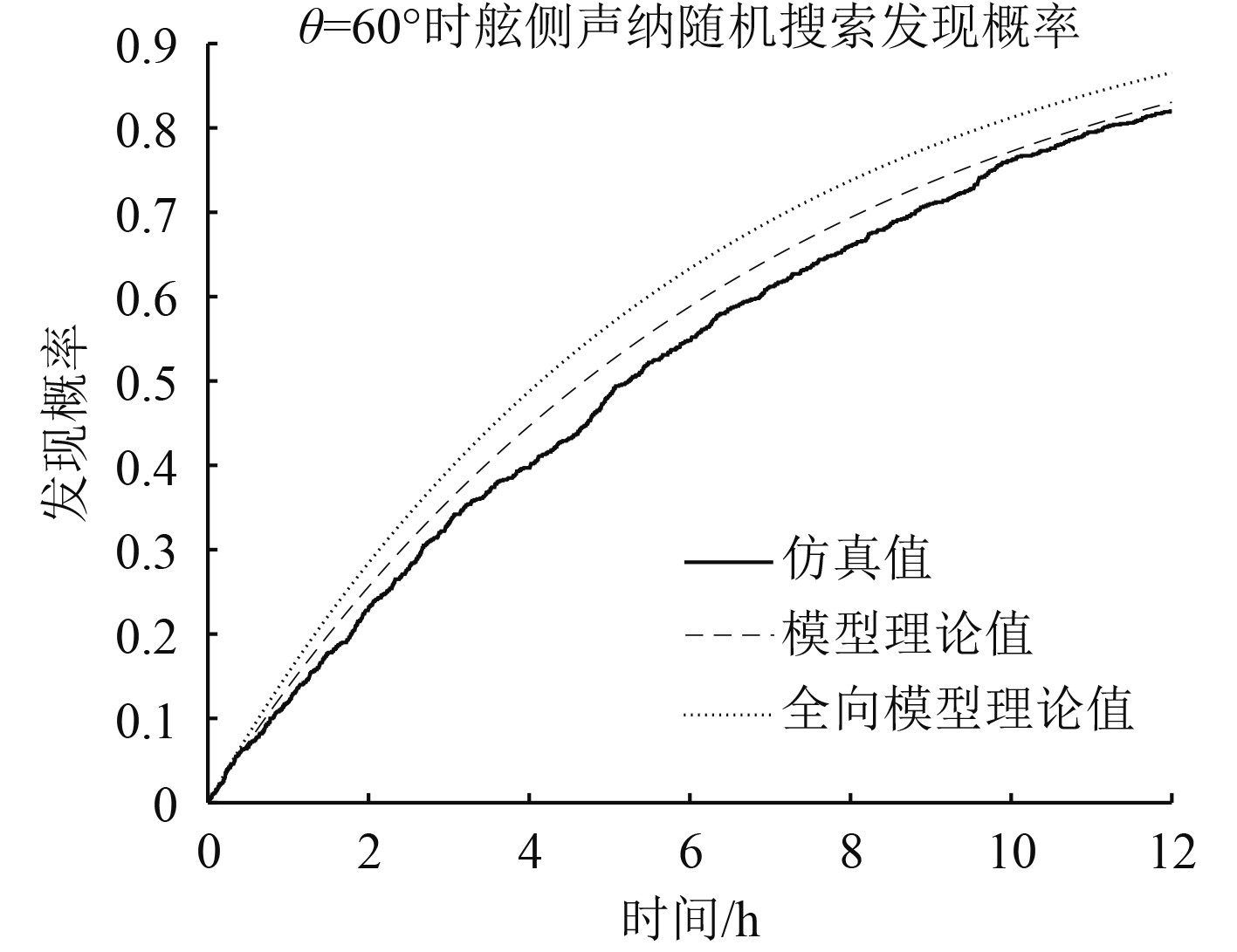
|
图 8
随机搜索发现概率对比图(
|

|
图 9
随机搜索发现概率对比图(
|
由图8可以看出,相较于以2倍传感器作用距离为搜扫宽度的全向模型,基于式(1)、式(5)和式(23)等给出的模型更接近于仿真试验的结果,从而验证了模型在随机搜索中的有效性和准确性。
图9表明2种模型较为接近,结合式(20)和式(21)可以看出:
| $ \Delta P = \left( {{e^{\frac{{\left( {2R - W} \right)Vt}}{A}}} - 1} \right){e^{\frac{{ - 2RVt}}{A}}}。$ | (25) |
进而表明,当

|
图 10 随机搜索中有效探测范围示意图 Fig. 10 Diagram of valid detection range in random search |
| $ P\left( t \right) = 1 - {\left( {1 - \frac{{VWt}}{{nA}}} \right)^n}。$ | (26) |
每次独立试验时均要求探测扇面完全位于搜索区域内,而这只有当
针对当前UUV采用潜艇搜索模型从而导致搜索效率存在误差的问题,以搜索论的相关概念为基础进行研究,对相对运动速度及不同扇面角和态势下的搜扫宽度进行计算与分析,区分首部声呐和舷侧声呐2种典型配置方案,建立非全向传感器作用下水下平台的搜索模型。仿真结果与模型理论计算值吻合较好,验证了模型对水下搜索问题研究的可靠性与准确性。
| [1] |
钟宏伟. 国外无人水下航行器装备与技术现状及展望[J]. 水下无人系统学报, 2017, 25(3): 215-225. ZHANG H W. Review and prospect of equipment and techniques for unmanned undersea vehicle in foreign countries[J]. Journal of Unmanned Undersea Systems, 2017, 25(3): 215-225. DOI:10.11993/j.issn.2096-3920.2017.03.001 |
| [2] |
鞠巍, 周银龙, 张浩. UUV的技术特点、作战运用及发展趋势[J]. 舰船论证参考, 2017, 1: 12-16. JU W, ZHOU Y L, ZHANG H. Technical characteristic, combat application and development tendency of UUV[J]. Ship Demonstration, 2017, 1: 12-16. |
| [3] |
张宏瀚, 郭焱阳, 许亚杰, 等. 多UUV搜索海底声信标任务规划方法[J]. 中国舰船研究, 2020, 15(1): 13-20. ZHANG H H, GUO Y Y, XU Y J, et al. Mission planning method of multi-UUV search submarine acoustic beacon[J]. Chinese Journal of Ship Research, 2020, 15(1): 13-20. DOI:10.19693/j.issn.1673-3185.01641 |
| [4] |
徐健, 朱慧龙, 陈涛, 等. 受人观测启发的UUV前视声纳滤波方法. 仪器仪表学报, 2016, 37(5): 1094–1099. XU J, ZHU H L, CHEN T, et al. Forward looking sonar filtering method for UUV inspired by humanoid observation[J]. Chinese Journal of Scientific Instrument, 2016, 37(5): 1094–1099. |
| [5] |
陈盼, 胡剑光, 尹志伟. UUV编队协同搜索静止目标的准最优方法[J], 火力指挥与控制, 2013, 38(4): 53–56. CHEN P, HU J G, YIN Z W. Quasi-optimal method for multiple UUVs cooperate to search static target[J]. Fire Control & Command Control, 2013, 38(4): 53–56. |
| [6] |
周宏坤, 葛锡云, 邱中梁, 等. UUV集群协同探测与数据融合技术研究[J]. 舰船科学技术, 2017, 39(12): 70-75. ZHOU H K, GE X Y, QIU Z L, et al. Research on UUVs cooperative detection and data fusion[J]. Ship Science and Technology, 2017, 39(12): 70-75. DOI:10.3404/j.issn.1672-7649.2017.12.015 |
| [7] |
常波, 周晓光, 田怀英, 等. 舰载反潜直升机吊放声纳区域反潜策略建模[J]. 火力与指挥控制, 2017, 42(8): 68-75. CHANG B, ZHOU X G, TIAN H Y, et al. Modelling and research on area searching strategies for antisubmarine helicopter with dipping sonar[J]. Fire Control & Command Control, 2017, 42(8): 68-75. DOI:10.3969/j.issn.1002-0640.2017.08.016 |
| [8] |
郭齐胜, 曹晓东, 王文悦, 等. 战斗建模[M]. 北京: 国防工业出版社, 2002.
|
| [9] |
蔡云祥, 初磊, 陈雄民. 潜艇隐蔽突破反潜潜艇封锁区域能力评估模型研究[J]. 舰船电子工程, 2016, 36(8): 36-51. CAI Y X, CHU L, CHEN X M. Evaluation model of submarine’s capability of stealthily breaking through adverse submarine’s blocked area[J]. Ship Electronic Engineering, 2016, 36(8): 36-51. DOI:10.3969/j.issn.1672-9730.2016.08.009 |
| [10] |
张建强, 刘忠, 杨红梅. 基于搜索论的远程反舰导弹搜捕概率建模方法[J]. 国防科技大学学报, 2015, 37(4): 188–194. ZHANG J Z, LIU Z, YANG H M. The target acquisition probability modeling method of long-range anti-ship missile based on search theory[J], Journal of National University of Defense Technology, 2015, 37(4): 188–194. |
| [11] |
邹佳运, 曲泓玥, 陈志鹏. 大规模水下滑翔机集群区域覆盖探测路径规划[J]. 水下无人系统学报, 2021, 29(1): 23-29. ZOU J Y, QU H Y, CHEN Z P. Path planning of a large-scale underwater glider swarm area coverage detection[J]. Journal of Unmanned Undersea Systems, 2021, 29(1): 23-29. DOI:10.11993/j.issn.2096-3920.2021.01.04 |
 2022, Vol. 44
2022, Vol. 44
